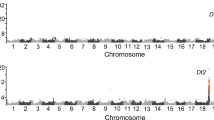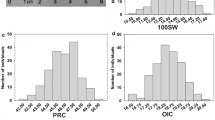Summary
Four soybean seed urease nulls (lacking both the activity and antigen of the embryo-specific urease) were intermated and the F1 and F2 seed examined for urease activity. Both generations were without urease activity, and the nulls were therefore considered noncomplementing. In crosses of each null line to cultivars homozygous for the allelic, codominantly inherited urease slow or fast isozyme, the F1 seed expressed the embryo-specific urease isozyme of the urease-expressing parent. A 3 ∶ 1 segregation for presence and absence of urease was observed in progeny from F1 and heterozygous F2 plants. The F2 and F3 from fastXnull combinations revealed that urease-positive seed were all phenotypically urease fast, while the same seed from slowXnull combinations showed a segregation of one seed containing a fast urease, either exclusively or in a heterozygous state with the slow isozyme, for every 69 phenotypic slows. Data pooled from F2 plants which segregate for both the presence (Sun) and absence (Sun) of urease and for the fast (Eu1-b) or slow (Eu1-a) urease allele indicate that the null lesion (Sun) is linked to Eu1 by approximately one map unit. The evidence is consistent with two models: (1) sun is an allele at the embryo-specific urease isozyme locus (Eu1) and that a high degree of exchange (and/or conversion) within the locus results in a 1% recombination frequency between the null trait and urease allozyme; (2) sun is at a distinct locus which is separated by one map unit from the embryo-specific urease isozyme locus (Eu1) upon which it acts in the cis position. Polyadenylated embryo RNA from one of the null lines, PI 229324, exhibited no urease template activity in vitro. Thus, the lack of urease antigen is due to lack of accumulation of translatable urease mRNA. The availability of soybeans lacking seed urease should be extremely useful to breeders as a trait for linkage studies and to geneticists as a transformation marker.
Similar content being viewed by others
References
Allard RW (1956) Formulas and tables to facilitate the calculation of recombination values in heredity. Hilgardia 24:235–278
Aviv H, Leder P (1972) Purification of biologically active messenger RNA by chromatography on oligothymidylic acid-cellulose. Proc Natl Acad Sci USA 69:1408–1412
Barlow JJ, Mathias AP, Williamson R, Gammec DB (1963) A simple method for the quantitative isolation of undegraded high molecular weight ribonucleic acid. Biochem Biophys Res Commun 13:61–66
Buttery BR, Buzzell RI (1971) Properties and inheritance of urease isoenzymes in soybean seeds. Can J Bot 49:1001–1005
Clark SH, Daniels S, Rushlow CA, Hilliker AJ, Chovnick A (1984) Tissue specific and pretranslational character of variants of the rosy locus control element in Drosophila melanogaster. Genetic 108:953–968
Chovnick A, Gelbart W, McCarron M, Osmond B, Candidio EPM, Baillie DL (1976) Organization of the rosy locus in Drosophila melanogaster: evidence for a control element adjacent to the xanthine dehydrogenase structural element. Genetics 84:233–255
Davis BJ (1964) Disc electrophoresis II. Methods and applications to human serum proteins. Ann NY Acad Sci 121:404–427
Dennis ES, Gerlack WL, Pryor AJ, Bennetzen JL, Inglis A, Llewellyn D, Sachs MM, Ferl RJ, Peacock WJ (1984) Molecular analysis of the alcohol dehydrogenase (Adh1) gene of maize. Nucleic Acids Res 12:3982–4000
Freeling M (1978) Allelic variation at the level of intragenic recombination. Genetics 89:211–224
Freeling M, Bennet DC (1985) Maize Adh1. Ann Rev Genet 19:297–323
Gabriel O (1971) Analytical disc gel electrophoresis. In: Jakoby WB (ed) Methods in enzymology, vol 22. Academic Press, New York, pp 565–578
Kerr PS, Blevins DG, Rapp BJ, Randall DD (1983) Soybean leaf urease: comparison with seed urease. Physiol Plant 57:339–345
Krueger RW, Chisholm D, Polacco JC (1985) Cloning and developmental regulation of soybean urease isozymes. In: 1st Int Congr Plant Mol Biol (Astr). Savannah GA, p 73
Kloth RH, Hymowitz T (1985) Reevaluation of the inheritance of urease in soybean seed. Crop Sci 25:352–354
Kloth RH, Polacco JC, Hymowitz T (1984) The inheritance of a soybean seed urease null mutation. Agron Abstr 1984:74
Lewin B (1980) Gene expression, vol 2, 2nd edn. Wiley and Sons, New York
Lowry OH, Rosenbrough NJ, Farr AL, Randall RJ (1951) Protein measurement with the Folin phenol reagent. J Biol Chem 193:265–275
McCarron M, O'Donnell J, Chovnick A, Bhular BS, Hewitt J, Candido EPM (1979) Organization of the rosy locus in Drosophila melanogaster: further evidence in support of a cis-acting control element adjacent to the xanthine dehydrogenase structural element. Genetics 91:275–293
Meyer-Bothling E, Polacco JC (1986) An ensemble of mutants in urease expression. Current topics in plant biochemistry and physiology, vol 5. University of Missouri, Columbia Mo
Nelson OE (1968) The waxy locus in maize. 2. The location of the controlling element alleles. Genetics 60:507–524
Ouchterlony O (1948) In vitro method for testing the toxinproducing capacity of diptheria bacteria. Acta Pathol Microbiol Scand 25:186–191
Polacco JC, Havir EA (1979) Comparisons of soybean urease isolated from seed and tissue culture. J Biol Chem 254:1707–1715
Polacco JC, Thomas AL, Bledsoe PJ (1982) A soybean seed urease-null produces urease in cell culture. J Biol Chem 254:1707–1715
Polacco JC, Sparks Jr RB (1982) Patterns of urease synthesis in developing soybeans. Plant Physiol 70:189–194
Polacco JC, Winkler RG (1984) Soybean leaf urease: a seed enzyme? Plant Physiol 74:800–803
Polacco JC, Krueger RW, Winkler RG (1985) Structure and possible ureide degrading function of the ubiguitous urease isozyme of soybean. Plant Physiol 79:794–800
Stahlhut RW, Hymowitz T, Orf JH (1981) Screening the USDA Glycine soja collection for presence or absence of a seed lectin. Crop Sci 21:110–112
Wessler SR, Varagona MJ (1985) Molecular basis of mutations at the waxy locus of maize: correlations with the fine structure genetic map. Proc Natl Acad Sci USA 82:4177–4181
Winkler RG, Polacco JC, Eskew DL, Welch RM (1983) Nickel is not required for apourease synthesis in soybean seeds. Plant Physiol 72:262–263
Author information
Authors and Affiliations
Additional information
Communicated by A.L.Kahler
Portions of this work were funded by the Illinois and Missouri Agricultural Experiment Stations, the SOHIO-University of Illinois Center of Excellence in Crop Molecular Genetics and Genetic Engineering and by grants PCM-8219652 from the National Science Foundation and USDA/SEA-CRCR-1-1374 from the USDA Competitive Grants Office
Rights and permissions
About this article
Cite this article
Kloth, R.H., Polacco, J.C. & Hymowitz, T. The inheritance of a urease-null trait in soybeans. Theoret. Appl. Genetics 73, 410–418 (1987). https://doi.org/10.1007/BF00262509
Received:
Accepted:
Issue Date:
DOI: https://doi.org/10.1007/BF00262509




